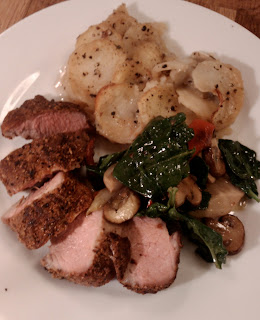It has to be said that, generally, Jack Spratt would have a tough time round here. A lean time you might say. His wife on the other hand, might just find herself facing unaccustomed competition. We like our fat. Oxtail, ox cheeks, lamb neck, ribs. Give me a rib eye over a fillet steak any time. And I can’t believe I’ve blogged for a month now and not mentioned pork belly more than in passing.
Nevertheless, there are one or two lean cuts that I am particularly partial to: Hanger steak, aka onglet, is another of those “forgotten cuts”, that I believe may not have been so much forgotten by us, as concealed from us – it’s also known as butcher’s steak, on account of the butcher keeping it for himself - although when you do find it, it is fortunately still a bargain compared to other, to my mind much less interesting cuts of steak. Yes, fillet, I'm talking about you again... Tenderloin of pork on the other hand is widely available, still reasonably priced, tender, delicious, versatile and convenient.
 Convenience is a damning with faint praise kind of word, but that’s not at all how I mean it in this case. What I mean is sometimes a joint of meat is too much, a wild extravagance and quite a palaver for a midweek dinner for two. Pork tenderloin is a quick and easy alternative, and in no way a second rate option. Roast dinner for two in no time, with no waste, no fuss, and no great quantity of washing up.
Convenience is a damning with faint praise kind of word, but that’s not at all how I mean it in this case. What I mean is sometimes a joint of meat is too much, a wild extravagance and quite a palaver for a midweek dinner for two. Pork tenderloin is a quick and easy alternative, and in no way a second rate option. Roast dinner for two in no time, with no waste, no fuss, and no great quantity of washing up. Just get down your pestle and mortar and rummage in your spice store. I went with black peppercorns, fennel and coriander seeds and a star anise, pounded with rock salt, but you could use cumin, aniseed, or whatever you like, really. Then I mixed the crushed spices with plenty of paprika (sweet on this occasion, but by all means use smoked, or hot). Then I rolled the pork fillets in the mix, browned them in the pan and put them in the oven at around 200 for about 15-20 minutes. Let the fillets rest for 10 minutes, then slice them and plate up.
That’s it. It really is that easy, and it really doesn’t get any more complicated, however many people your cooking for. That’s the other great thing about roasting tenderloins, they are just so easily scaleable. There’s no great logistical or technical challenge, it’s just a question of doing more, or less. It really is as suited, and as easy to do, for two or for twelve. I’ve served this up for a party of fifty, out of a regular domestic kitchen, for that very reason. While most dishes, once you scale up beyond a certain point, call on a whole new set of skills - most of them logistical - this one just calls for more roasting trays. You don’t even need an unusually large oven.
One last thing. You may have noticed in the picture that the meat is cooked pink. Pork can be pink. It should be pink. Think about it: It’s not like beef or lamb, it doesn’t start off red, it starts off a kind of semi translucent beige, so by the time it’s turned a nice delicate rose pink, it’s cooked. By the time it’s turned beige again, or even worse, white, it’s way over done. It’ll be dry, fibrous and taste of bugger all, no matter what kind of tasty crust you wrap it in.

No comments:
Post a Comment